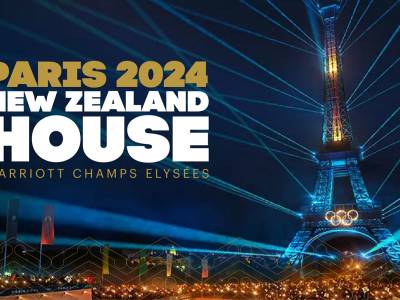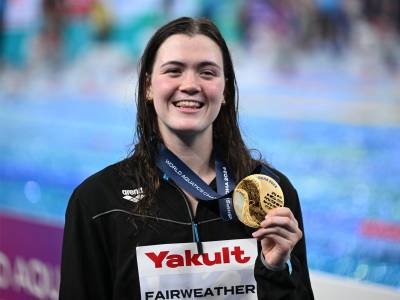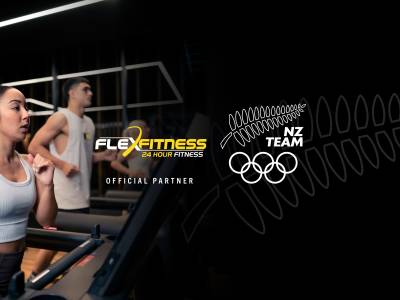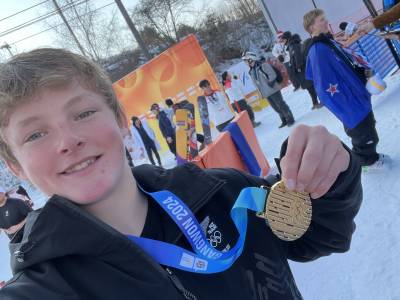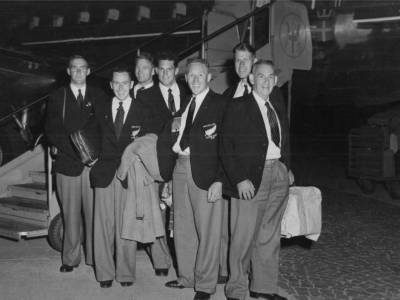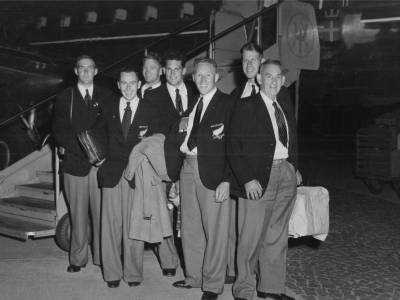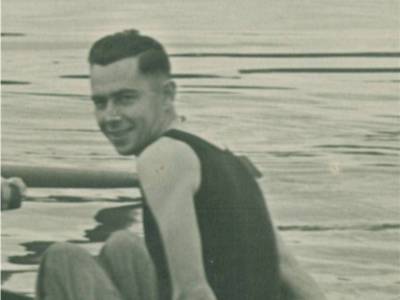John was a great stalwart of the Aramoho Rowing Club in Wanganui in the years after World War 2.
In 1945 at the age of 18 years old, John was sent down to the Aramoho Rowing Club by a family friend. Upon arriving he couldn't find anyone, so was on his way back up to the road he was stopped by a loud voice. Doug Holmes had spotted him leaving and called him back. He was put into a boat and here started his rowing career. He caught 5 crabs on his first outing, but that was the only time – this never occurred again.
His progression was rapid, the next season 1946-47 he was put into the Premier Eight and they won the NZ Champs. He was a very strong and tough man, totally suited to rowing.
1947-48 the Aramoho Premier Eight defended their title, and travelled to Australia to compete in the NSW Champs which they won.
1949-50 saw him in a Coxed Four. This Four4 was quite outstanding and it won the NZ Champs and the Boss Rooster that year. The Aramoho Coxed Four was selected to represent New Zealand at the Empire Games which were being held in Auckland. Before his selection in a composite crew to compete at the 1952 Olympic Games in Helsinki, Finland, he had won several New Zealand Championship titles, the New South Wales State title for eights. He won a gold medal in ‘the Aramoho Coxed Four' which represented New Zealand in the 1950 Empire Games regatta at Lake Karapiro – the first international regatta held at that venue. The Aramoho Eight won another title in 1950.
1951-52 John won his 5th Red Coat in the Aramoho Coxed Four. John O'Brien and Ted Johnson were selected for the 1952 Olympic Four along with Kerry Ashby and Bill Tinnock of the West End club, Auckland. Colin Johnstone of Aramoho was the cox and Hec McLeod of Poverty Bay was the reserve. The crew, along with the rest of the New Zealand team, had to go virtually to 'the end of the earth' in Finland leaving by flying boat from Evans Bay in Wellington. The only lead-up race the crew had prior to the Olympics was as an unfamiliar coxless four at the Royal Henley Regatta in London. They performed well despite the fact that they had never rowed in that type of shell previously.
At the Olympic regatta, the crew made strong showings in its two races, leading into the last 200 metres, but lack of hard racing before the Olympics told in the final stages. They didn't really perform to their expectations which was a huge disappointment for John, he believed they had peaked prior to Helsinki. They had learned new ideas and techniques for training from the other international crews, and upon returning to New Zealand tried to introduce them at the Aramoho Club. This opportunity for improvement in the Club wasn't accepted and it was the beginning of the end for John's involvement with rowing. They were no longer selected for any of the Aramoho crews at the New Zealand Championships, so they were invited to row for the West End Rowing Club which caused all sorts of outrage from Aramoho. John's response was to call an end to his rowing career, at the very young age of 25.
John O'Brien was a particularly powerful rower with excellent technique and great stamina.
John, Ted, and the cox Colin Johnstone were the first New Zealanders to have competed in a rowing event at the Olympics since 1932. They all played an important part in the development of the great traditions of this sport that have been forged in the post-World War 2 era.
Tweet Share
John's Games History
-
Olympic Summer Games Helsinki 1952
-
Commonwealth Games Auckland 1950
- 1

